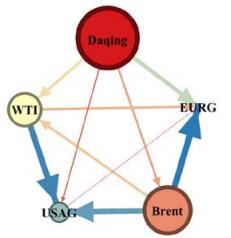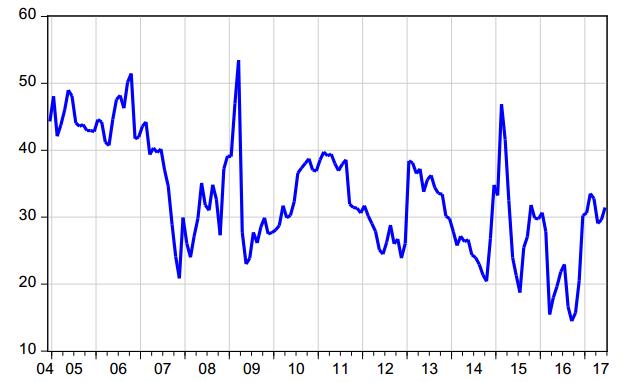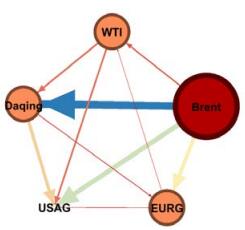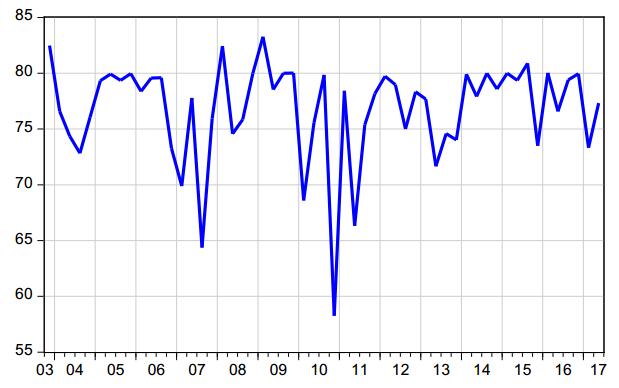In this paper, we highlight and empirically analyze the spillover effect of oil and natural gas prices between emerging and developed countries over the period from December 2001 to Jun 2017. A Granger causality test and the DY spillover index are used to investigate the connectedness in energy markets of the USA, Europe, and China. Our main findings are that oil and natural gas markets have significant Granger causality. Furthermore, the emerging markets play an important influencing role on many developed markets both in returns and volatility spillover systems. The spillover index between different markets has clear time-varying characteristics and a strong correlation with specific events. These results can have good applicability in practice.
1.
Introduction
In 1985, Kyle [1] established an equilibrium model in which a neutral trader possesses private information on the value of a risky asset. Subsequently, Back [2] revisited a continuous-time version of the Kyle model. Using stochastic control theory, signal filtering techniques, and signal filtering theory, Back derived a unique equilibrium within a certain class.
In real trading markets, market equilibrium is influenced by a variety of key factors. In 2020, Banerjee and Breon-Drish[3] extended Kyle's framework [1] by incorporating unobservable and costly information acquisition. They assumed that the volatility of liquidity traders follows a general, positive stochastic process, which directly implies that insider information evolves over time. Subsequently, Han et al. [4] examined the long-range dependence characteristic of market liquidity. More recently, Qiu and Zhou [5] not only modeled the volatility of risky assets as a random process, but also developed a random deadline insider trading model under dynamic asset conditions.
From the above mentioned, we realize that the impact of dynamic assets on market equilibrium is significant, because insider will update his/her private information over time. Moreover, insider behavior is one of the key factors affecting market equilibrium. For example, Baruch [6] considered a risk-averse monopolist model and assumed that liquidity traders' instantaneous demand depended on the cost of trading. His conclusion indicated that market depth increased over time. Later, Cho [7] extended the uniqueness result from the model of Kyle [1] and Back [2], and pointed out that market liquidity decreases over time if an insider is risk-averse. Recently, Xiao and Zhou [8] also considered a risk-averse model, but, unlike Baruch [6] and Cho [7], they analyzed a risky asset whose value is driven by an arithmetic Brownian motion, as in [9,10], and established a closed-form equilibrium with a risk-averse insider. In fact, there is lots of literature on continuous-time risk-averse models [11,12], and discrete-time risk-averse models [13,14]. However, risk-seeking literature has been less relatively addressed.
Why do most insider trading models tend to treat insiders as risk-averse or risk-neutral individuals? Tversky and Kahneman [15] provided their perspective in 1979, suggesting that when investors face uncertain decision-making, their investment behavior deviates from the rational models of classical financial theory due to the influence of personal and social factors. The risk attitude and behavior patterns often deviate from the optimal models of classical financial theory. They argued that when an investor is confronted with certain gains, they are generally risk-averse, seeking to minimize risk. However, when faced with certain losses, the investor is more inclined to take risks, focusing on the volatility of returns rather than the stability of those returns. As a result, risk-seeking investors are more likely to choose higher-risk assets in pursuit of higher returns.
From the perspective of behavioral economics, it is reasonable for most insider trading models to assume that insiders are either risk-averse or risk-neutral. However, it is important to note that this assumption reflects a subjective tendency, not an absolute truth. In reality, it is entirely possible for an insider to be a risk-seeking investor, as psychological factors, such as an abnormal mentality, can significantly influence an investor's risk preferences. Research by Frank et al. [16] indicates that CEOs, for example, may exhibit lower self-control, abusing their informational advantages to make profits, sometimes engaging in more aggressive trading behaviors. Furthermore, overconfidence in investors often leads to excessive self-assurance in their judgments and an overestimation of their chances of success. This, in turn, can lead to overreaction and excessive trading, causing the investor to behave as a risk-seeking agent. Zhou[17] examined a public disclosure model where an insider, overconfident in his private information, initially refrained from aggressive trading. This strategy aimed to preserve information for future trades, reflecting the insider's risk-seeking behavior. Kyle et al.[18] studied a continuous-time model and described the overconfident trading behavior of oligopolistic insider with exponential utility. In addition, several studies [19,20] have explored these behaviors, demonstrating that insiders, under certain conditions, can indeed act as risk-seeking investors.
Kyle et al.[18] describe a symmetric continuous-time model of trading among relatively overconfident, oligopolistic informed traders with exponential utility. Traders agree to disagree about the precisions of their continuous flows of Gaussian private information.
In fact, in 2010, Gong and Zhou [21] examined mixed equilibrium in a rationally expected price model under different risk preferences, noting that market liquidity increases over time. Subsequently, Gong and Zhou [22] developed a risk-seeking insider trading model within the context of Stackelberg equilibria. In 2023, Xiao [23] investigated a risk-seeking insider trading model in a continuous-time framework, where market makers could observe partial information about the risky asset. Using filtering theory and the dynamic programming principle, he proved the uniqueness and existence of a solution to the model. Unfortunately, in his assumptions, the risky asset is static, so market makers' partial information is integrated into the initial price at the beginning, making the partial observation coefficient always zero. In fact, partial observation has been studied by many researchers [24,25,26], but their models typically assume the risky asset is static. In my view, the risky asset should be dynamic. Therefore, we aim to improve and extend the previous model.
Next, this paper makes the following assumptions: (i) the insider is risk-seeking, (ii) the risky asset is dynamic, and (iii) market makers can receive partial signals about the risky asset. The remainder of the paper is organized as follows. Section 2 presents the preliminaries, including a definition of risk-seeking linear equilibrium. Section 4 outlines some necessary conditions for market efficiency. The main conclusions, including the existence and uniqueness of the equilibrium, are presented in Section 5. Section 6 provides numerical simulations of the equilibrium, and conclusions are drawn in Section 7.
2.
Preliminaries
Before introducing our model, we first assume that all randomness originates from a common filtered probability space (Ω,F,{Ft}t≥0,P), which satisfies the usual conditions[27]. Following this, we present the formulation of the optimal filtering problem below:
Theorem 2.1. [28] Let (θ,ξ) be a random process with differentials given by (2.1) and (2.2), and the conditions (1)–(10) be satisfied in [28]{12.3 Optimal Filtering Equations in Several Dimensions}. Then the vector mt=M(θt|Fξt) and the matrix γt=M((θt−mt)(θt−mt)∗|Fξt) are unique continuous Fξt-measurable for any t solutions of the system of equations
where B∘B=B1∘B∗1+B2∘B∗2, b∘B=b1∘B∗1+b2∘B∗2, b∘b=b1∘b∗1+b2∘b∗2, and C∗ is a transpose of C.
3.
The model
In a risky market, there is a risky asset traded in a finite continuous-time interval [0, 1], with its value, denoted as vt, evolving according to
where v0 is normally distributed with mean 0 and variance σ2v0, and Bv is a standard Brownian motion. There are three types of traders participating in the market:
(ⅰ) risk-seeking insider, who possesses the information regarding the liquidation value vt, and chooses his/her trading strategy xt as follows:
where β is a positive deterministic function, referred to as insider trading intensity[1];
(ⅱ) liquidity traders, who submit random trading volume zt in the following form[7]:
where σz is a positive deterministic constant, and Bz is a standard Brownian motion that is independent of vt;
(ⅲ) risk-neutral market makers, who observe the total orders of risk-seeking insider and noise traders (but do not observe them separately)
and obtain a signal ut on risky asset vt
where ϵt=ϵ0+∫t0σϵdBϵs is independent of vt and Bzt, and ϵ0∼N(0,σ2ϵ0). Subsequently, based on the trading volume yt and the signal ut, they set the market price pt as a linear function satisfying:
where λy and λu are two deterministic, measurable, and differentiable functions, referred to as the market liquidity parameter and the partial observation coefficient, respectively.
Then, approximately, the ex-ante profit for insider from time t to 1 is given by:
Based on the characteristics of risk-seeking insider, we assume she/he has an exponential utility function from time t to 1 in the following form:
Of course, the following conditions should be guaranteed, ∫10λ2tdt<∞, ∫10β2tdt<∞, and E(exp∫1tβs(vs−ps)2ds)<∞. Otherwise, it is difficult to guarantee its well-posedness. Next, the concept of equilibrium will be given as follows.
Definition 3.1. A risk-seeking linear equilibrium is a series (β,(λy,λu)) such that
(i) maximization of utility: for the given (λy,λu), the trading intensity β maximizes
where the insider's information domain FIt=σ{v}∨σ{ps,0≤s≤t} for t∈[0,1), and
(ii) market semi-strong efficiency: for the given β, a pair (λy,λu) ought to satisfy
where FMt=σ{u}⋁σ{ys,0≤s≤t} for t∈[0,1).
Remark 3.1. In this model, market makers can't obtain profit from trading, that is to say
Therefore, if market makers are not risk-neutral, the pricing process is not a martingale process, which will eventually lead to unfair market.
4.
Necessary condition for market efficiency
In our model, the signal-observation system is given by
where ξt=(ytut), ξ0=(0v0+ϵ0), A0=(−ptβt0), A1=(βt0), A2=(0σv), A3=(σz00σϵ), Bt=(BztBϵt).
By Theorem 2.1, we get
where
and
in addition, Σt=E[(vt−pt)2] is called residual information [1] with Σ0=σ2ϵ0σ2v0σ2v0+σ2ϵ0.
5.
Existence and uniqueness for equilibrium
In the following section, we will investigate the risk-seeking linear equilibrium. Let ms=vs−ps, combine (3.1) with (3.6), then
Let (β,(λy,λu)) be a linear equilibrium. From Definition 3.1, the insider's value function for t∈[0,1] is given by
where U(t,β) is the collection of the functions ˜β, such that ˜βs=βs for 0≤s≤t, and the two conditions for (5.2) are ensured
It is obvious that the first result is immediate, and the second can be deduced from Eqs (4.2) and (4.4), along with the equality limt→1−Σt=0.
In fact, it is straightforward to apply Bellman's principle to the stochastic version of the insider trading problem.
Proposition 5.1. Given t∈[0,1), for ˆt∈[t,1],
Proof. Omit. □
With the help of dynamic programming principle[27], we derive the following Hamilton-Jacobi-Bellman (HJB) equation.
Proposition 5.2. If the insider's value function is V(t,mt) in Proposition 5.1, then the HJB equation is
Proof. By Proposition 5.1 with ˆt−t→o and Itˆos formula, we obtain
obviously,
or
and 1−exp−∫ˆttβsms2dsˆt−t∼βtmt2 as ˆt→t. Hence, we have
□
Proposition 5.3. If the insider's value function satisfies (5.5), then it can be portrayed as
where
and the constant c1 satisfies the following equation,
Proof. We know that the HJB equation (5.5) is equivalent to the following system:
In the system (5.10), the second equation can be viewed as an ordinary differential equation in terms of mt, which leads to the following:
where g(t) is a deterministic function on [0, 1].
Substituting (5.11) into the first equation in system (5.10), we obtain
and it is equivalent to the following two equations
From the Eq (5.13), we get
Let τ=(σ2vσ2z(1−λut)2+σ2ϵσ2zλ2ut)1/2, then we have
where c1=arctan(τλy0). We take it into the Eq (5.12), then
where g0=expσ2z2∫10tan(c1−σ2zτs)τ(τ+τ2tan2(c1−σ2zτs))ds=(tan(c1−σ2zτ)cotc1)1/2. According to the boundary conditions in (5.3), the constant c1 can be solved by
□
Theorem 5.1. Let −π2<c1−τσ2zt<π2, then there is a unique linear equilibrium (β,λ) satisfying
At the equilibrium, the residual information Σt is
and the insider's total ex-ante utility
where c1 is satisfied with the following equation:
Proof. From the Eq (4.4), we have
Taking (5.14) into it, we have
Again, together with λyt=Σtβtσ2z in (4.3), we obtain
By the properties of expectation, we have
where
The proof is complete. □
Corollary 5.1. In Theorem 5.1, the following result holds:
As time progresses, both market liquidity and optimal trading intensity increase simultaneously; the partial observation coefficient remains constant, whereas residual information decreases.
Proof. Omit. □
6.
Numerical simulation
In Theorem 5.1 and Corollary 5.1, we provide some theoretical characteristics of equilibrium. Next, we will present numerical simulations for the equilibrium. In order to understand the equilibrium characteristics of dynamic assets, we will compare them with the equilibrium of static assets [23]. In Xiao's article[23], a unique linear equilibrium (β,λ) is presented, satisfying
where
In the following, we will examine the various characteristics of market equilibrium individually. To simplify the calculations, we assume that σ2v=σ2v0,σ2ϵ0=σ2ϵ. For more intuitive, Table 1 provides some special parameters. We mainly compared Xiao's model[23], which is a static risky asset.
In Figure 1, we intuitively illustrate the characteristics of equilibrium and observe how market liquidity evolves over time. It is evident that market liquidity increases exponentially. When comparing dynamic and static risky asset, market liquidity in dynamic assets is higher than in static assets when the volatility of risky asset is low. However, as the volatility of risky asset increases, market liquidity in dynamic risky asset initially becomes lower than in static assets, but eventually surpasses that of static assets. This suggests that the volatility of dynamic risky asset is a key factor in determining the level of market liquidity and the activity of the risk market.
In Figure 2, whether the risk assets are dynamic or static, the partial observation coefficient remains constant over time. Moreover, as the volatility of risk assets increases, the partial observation coefficient steadily increases. However, the partial observation coefficient always remains zero in the case of static assets. In fact, the partial observation information in static assets will be integrated into market pricing initially, hence the partial observation coefficient remains zero. Unlike static assets, dynamic risk assets are continuously changing, which leads to partial observation coefficients fluctuating with volatility.
In Figure 3, it is evident that the insider's residual information consistently decreases when the risky asset remains static. Furthermore, when the volatility of the risky asset is low, the insider's residual information gradually decreases. However, as the volatility of the risky asset increases, at the beginning of trading, the insider's residual information not only fails to decrease but also increases, which contradicts our initial intuition. This phenomenon can be explained by the insider's characteristics and the fundamental significance of residual information. First, the insider is generally risk-seeking, and a risk-seeking insider is less likely to release private information early in the trading process. Moreover, considering the expression for residual information, Σt=E[(vt−pt)2], where pt=E[vt|FMt], we can see that an increase in residual information Σt must arise from one of two conditions: (1) the market maker's pricing deviates from the true price, or (2) the risky asset vt experiences significant volatility. Hence, this explains why the release of private information is reduced initially and why residual information increases when volatility is high.
In Figure 4, when the volatility of risk assets is low, the trading intensity of dynamic risk assets is higher than that of static risk assets. However, as the volatility of risk assets increases, the trading intensity of dynamic risk assets gradually decreases, eventually falling below that of static risk assets. When volatility is low, the insider can more effectively control the information, resulting in relatively high trading intensity. In contrast, as volatility increases, the insider becomes more cautious, leading to a lower trading intensity. This suggests that the stability of information plays a crucial role in influencing the insider's trading behavior.
7.
Conclusions
In this paper, we establish the existence and uniqueness of the linear equilibrium in a continuous-time insider trading model, where the insider is assumed to be risk-seeking, and market makers observe partial signals on the risky asset; moreover, the risky asset is assumed to be driven by Brownian motion.
This paper has found the above conclusion: (ⅰ) the partial observation coefficient remains constant over time for both dynamic and static risk assets. It increases with volatility in dynamic assets but stays zero for static ones, as their partial observation information is quickly integrated into market pricing. In contrast, dynamic assets cause fluctuations in the coefficient.
(ⅱ) In a risk-seeking trading market, dynamic risky assets play a key role in influencing market equilibrium. When the volatility of these assets is low, market liquidity remains relatively stable, with a steady, albeit slight, increase over time. However, as the volatility of risky assets increases, market liquidity undergoes exponential changes, significantly enhancing liquidity and fostering market development. This aligns with economic intuition: when volatility is high, the insider finds it more difficult to manage these assets, which in turn makes it harder for them to generate profits. In comparison to risk-averse and risk-neutral agents, liquidity traders reduced losses, and their participation becomes more pronounced in a risk-seeking environment. To maximize potential profits, insider is also more likely to engage actively in trading.
(ⅲ) The insider's residual information decreases when the risky asset remains unchanged. Under low volatility, the residual information steadily declines. However, as the volatility increases, the residual information initially increases, which contradicts intuition. This can be attributed to the insider's risk-seeking behavior, as they are less inclined to disclose private information early in trading. The residual information will increase if market makers' pricing deviates from the true value or when asset volatility is high, explaining the delayed release of information and the corresponding increase in residual information with higher volatility.
(ⅳ) When volatility is low, dynamic risk assets trading intensity is higher than that of in static assets. However, as volatility increases, the trading intensity of dynamic assets diminishes, eventually falling below that of static assets. In a low-volatility environment, insiders can more effectively manage information, leading to greater trading activity. In contrast, rising volatility prompts insiders to adopt a more cautious stance, reducing trading intensity. This highlights the crucial role of information stability in influencing insider trading behavior.
On the whole, at equilibrium, as time goes by, both market liquidity and trading intensity increase rapidly in the later, while residual information decreases slowly at the beginning, and partial observation coefficient is only related to randomness but independent of time. Specifically, the market liquidity characteristic suggests that the insider is more willing to trade and has a stronger desire to trade when less residual information is available.
Note that, our model extends Kyle's (1985) framework [1] by incorporating a risk-seeking perspective. In Kyle's original model, market liquidity is assumed to be constant. In contrast in risk aversion [6,7,12] models, the market liquidity typically decreases over time. Different from the models mentioned above, in our model, market liquidity is an increasing function with time. From a broader perspective, it is beneficial for market development when the insider adjusts their risk appetite appropriately.
Use of Generative-AI tools declaration
The author declares that he has not used Artificial Intelligence (AI) tools in the creation of this article.
Acknowledgments
The author want to thank Professor Yonghui Zhou, who carefully revised our manuscript, and provided many suggestions and assistance on the review comments. The paper is supported by Guizhou QKZYD[2022]4055, the innovative exploration and new academic seedling project of Guizhou University of Finance and Economics (No. 2022XSXMB25).
Conflict of interest
The author declares no conflict of interest in this paper.









 DownLoad:
DownLoad:












